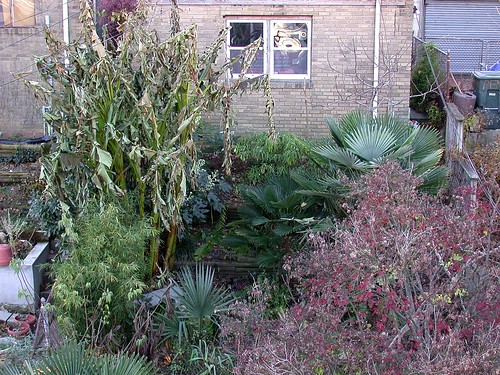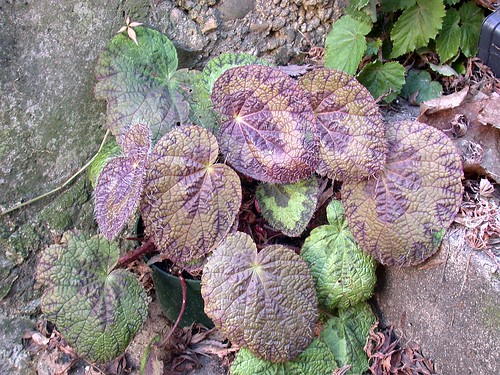
The end of the growing season has arrived for my hardy banana (Musa basjoo) and the rest of my garden as well. I took the above photo on my return to Washington, DC two weeks ago after being unexpectedly out of town for 9 days and found that there had been a hard freeze while I was gone. This wasn't entirely unexpected; I usually get my first light frost in mid November and a hard freeze in mid to late November. This is something that those of us growing tropical and subtropical plants in zone 7 have to confront sooner or later: they don't take well to freezing temperatures! On the other hand, the first hard freeze sometimes comes late enough that many of my plants look good well into December. But not this year! Because the following days were forecast to bring colder-than-usual temperatures, with nights in the mid-20's, I spent the day before leaving to visit my family in Buffalo for Thanksgiving scrambling to mulch plants and bring in any potted plants I wanted to save.
For most plants, putting the garden to bed simply means mulch, but I also have a lot of begonias in pots that need to be brought in. These two photos show the dramatic effect of an overnight freeze on a potted plant of Begonia sizemoreae two years ago, when our first hard freeze didn't come until early December:

Begonia sizemoreae, December 10, 2011

Begonia sizemoreae, December 12, 2011
The second photo was taken the next morning while the plant was still frozen, and the discolored leaves turned to mush shortly afterwards. Note that several of the leaves didn't freeze, and are still healthy and green. When temperatures are near freezing a single degree makes all the difference, and even a little shelter--sometimes even the plant's own upper leaves--can prevent a plant from freezing. But many of my other begonias are planted directly in the ground to test for hardiness, and sometime before the first frost I take cuttings of any I want to save so I can propagate them indoors over the winter as insurance:
Begonia leaves, ready for propagation
For my hardy palms, the only protection they receive is a thick mulch of autumn leaves around the base. For my begonias and other marginally hardy herbaceous plants, I generally apply a mulch of 1-2 inches of Leafgro (a locally produced leaf compost) followed by another two or more inches of fallen leaves, which I gather in my own yard, from my neighbors' yards, and even in the alley behind the house. When I peek under this mulch during the winter, I often find that the mulch itself is frozen solid but the soil just below it is not. For many marginal plants, that little bit of mulch can make the difference between surviving and not surviving.
Finally, for my banana I use what I call my "big pile o' crap" method of protection. Autumn leaves, the banana's own leaves, and anything else I cut down in the garden are thrown in a big pile around the base of the pseudostems. In the past it has even included a Christmas tree. It isn't pretty, but it does the job. By spring much of it has already decomposed, and I leave it in place to help nourish the plant.
Pile o' crap method of protection
So after a hard freeze and a bit of cleanup, this is what I'm left to look at. Fortunately the palms, the fatsia, and a clumping bamboo (Fargesia robusta) provide some green color all winter.

Insurance is great! Kartuz is my insurance. I don't have a greenhouse so I recently gave him a ton of plants that I haven't tested outside yet. I did the same thing last year as well. Actually I have a pretty large insurance network...but Kartuz is the only one with a real greenhouse. I'm pretty certain that the most important lesson is to keep your eggs in as many different baskets as possible.
ReplyDeleteI've only recently been growing plants from seed in order to try and select for cold/drought tolerance. Within the past month I sowed a gazillion seeds of Anthuriums, Gesneriads, tree Aloes, Rhipsalis, Medinillas...and I plan on sowing quite a bit more this week. They are all outside without any protection. I doubt it's going to freeze but I'm curious how much cool growing variation there will be.
Have you noticed much cold tolerance variation among a batch of seedlings?
Maybe, maybe not. I give my plants minimal protection in hopes of identifying/selecting hardy individuals, but it's sometimes hard to say why a particular plant survives or doesn't survive. For example my fatsias were grown from seed from 3 different sources, and all have been pretty hardy. Meanwhile one that I purchased in the houseplant section of a local nursery didn't survive its first winter.
ReplyDeleteI've had variable winter survival with some of my hybrid begonia seedlings, but I'm not sure if that's because they differed in hardiness or simply in vigor. And of numerous hybrid Seemannia seedlings that involved marginally hardy species, of which I hoped at least one or two would be hardy, not a single seedling has survived even a mild winter.